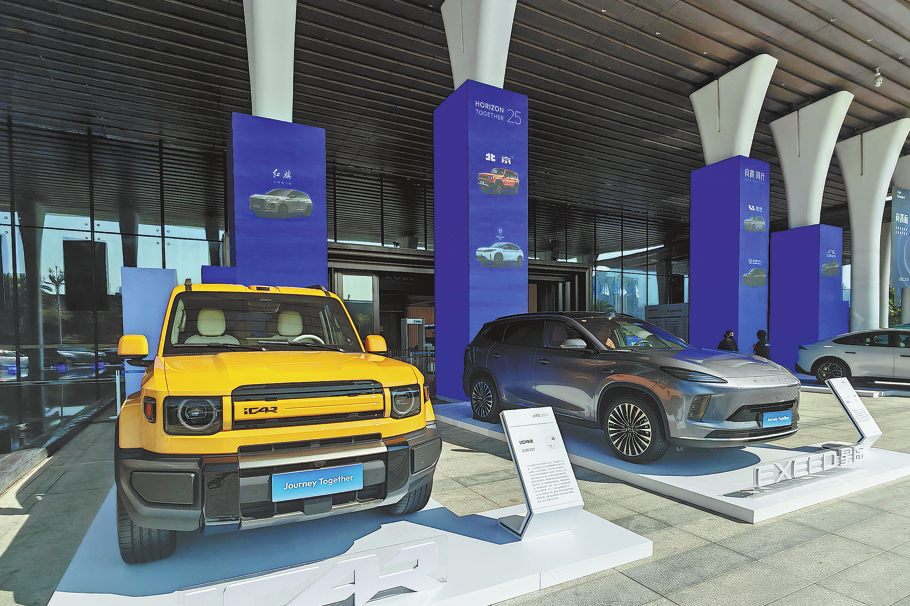A matter of life and death

A mother and her 15-year-old daughter do everything they can to get the treatment needed to survive
Gu Ruofan has only one thing to say to a newspaper reporter: "I want that drug!"
The 15-year-old's big eyes seem to conceal as much as they reveal.
| Gu Ruofan (left) took part with host Zhou Libo (center) in the popular television program Chinese Dream Show in 2012 to get the drugs she needs. Provided to China Daily |
Gu was diagnosed with a rare disease called mucopolysaccharidosis at the age of 4 - one of a series of inherited disorders affecting a type of carbohydrate that is deposited in body tissues because the person lacks the specific enzyme needed to break it down.
It damages and distorts the tissues, stunts a child's growth and development, limits their joint movement and in some (but not all) types, causes mental retardation.
"The alarm was first raised when I watched her dancing at kindergarten," says Zheng Yu, Gu's mother.
"My girl had always been a kinetic child, but she seemed to be needing extra effort just to raise her leg.
"The disease is progressive, which means she's getting worse and worse."
Gu's initial pain of not being able to dance or walk or even stand for long may now have gradually subsided, but another more ominous reality looms large on the horizon.
"The question for us is simple: whether she'll live or die in the next few years," adds Zheng.
"The drug that has been proven most effective for her condition is currently available in the United States, but not here in China.
"With that drug, she could be reasonably expected to live into her 40s or 50s. Without it, she stands a high chance of dying in her twenties."
The constant frustration and occasional despair Gu and her family have experienced is sadly all too typical in China.
"Due to the relatively small number of patients suffering from rare diseases, drugs developed for them at huge cost, are often sold at a loss," says Wei Min, a leading pediatrician with the Peking Union Medical College Hospital in Beijing.
"As well as a lack of preferential policies in China to encourage domestic pharmaceutical companies to develop new drugs to treat rare diseases, the speed with which the country imports foreign drugs is also so slow, that it effectively kills all hope for some patients."
In 2009, China's State Food and Drug Administration, under pressure from advocates in and outside of the medical profession, did open a fast track for the registration and importation of foreign drugs dealing with some rare diseases.
But according to Wei, the process still gets bogged down in red tape, which among other things include extensive documentation and clinical trials.
"The trials are impossible. Cost aside, for many types of rare diseases, I simply can't find the requisite 200 people to be my test subjects," she adds.
"And it's also emotionally, if not morally, fraught, since a clinical trial usually divides the subjects into two groups: those who receive the drug and those who do not.
"In a situation like this, almost all the patients desperately want to try the drug."
Gu was one of them. Back in 2010, when the drug now available in the US was still undergoing clinical trails, she went with her mother to Taiwan where BioMarin Pharmaceutical Inc, the California-based pharmaceutical company that developed the drug, needed a couple dozen volunteers for the test.
"We begged to be included, but the answer was a definite no," says Zheng.
"In fact, the company had chosen Taiwan because the drug, once proved effective, is very likely to be covered by the government-paid medical insurance there."
Since the treatment is virtually unaffordable - costing $450,000 (2,800,000 yuan) for a year's therapy - without medical insurance it's out of reach of most, even though it's available in theory.
"On the Chinese mainland, the government has consistently refused to cover the overwhelming majority of rare diseases - hemophilia being one of the rare exceptions - with medical insurance.
"Expecting no policy breakthrough in the near future, the Californian company says it cannot test the drug on Gu because even if it works, continued use is not ensured," her mother continues.
Wei Min believes that for anything meaningful to happen, policymakers need to undergo a fundamental change of mindset.
"Every single time I approach them, they ask me two questions: 'how many people will this involve, and how much money does it cost?' and I know we are not on the same wavelength.
"They simply do the math - but for patients and their families a rare disease is anything but a math problem."
In 2012, Gu took part in the popular television program Chinese Dream Show.
After completing a "sand painting" for the audience, she says her dream is to receive the drugs she needs.
"I had originally resisted the idea of appearing on television, because painting to me is a very soothing, private undertaking," Gu says.
"But my mother told me 'I've done everything I can for you, now it's up to you to save your own life', and I agreed."
At the end of the show, its celebrity host Zhou Libo promised to deliver the drug to Gu. But that promise was not going to be kept.
"I don't blame him - he really tried. Nor do I blame the American pharmaceutical company for being profits-driven," adds Zheng. "More than anything else, we want to see a policy change which could alter the landscape for China's rare disease patients."
Gu continues her fight for life, but her future still plays on her mind constantly.
"One day we were sitting on the sofa talking," remembers Zheng.
"My daughter turned to me and simply said, 'Mom, you must be happy, no matter what'."
(China Daily Africa Weekly 09/19/2014 page25)
Today's Top News
- HK's Jimmy Lai convicted in national security case
- China announces countermeasures against former Japanese senior official
- Australia set to further tighten gun control laws
- HKSAR security chief on conviction of Jimmy Lai
- Jimmy Lai's verdict sends clear messages
- Japanese scholar condemns Japan's risky defense spending































